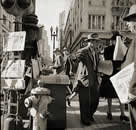By Carl Zebrowski
For one day—Sunday, December 7, 1941—the front and the home front were one and the same. America was under enemy attack. Japanese bombers hit the US naval base at Pearl Harbor, Hawaii, hard. Los Angeles could be next, or maybe New York. And after that, who knew? New Orleans? Chicago? Houston? Americans everywhere were in this thing together.
Word of the Pearl Harbor attack arrived almost immediately by phone at the White House. Elsewhere in the nation, the news spread like wildfire over the radio and by word of mouth. Families gathered in their living rooms and listened to radio news for hours.
Rumors surfaced that Japanese bullets and bombs were hitting other American targets. There were reports of US ships sunk at sea, the Panama Canal being blocked, and California coming under siege, with Japanese forces establishing a beachhead at San Francisco and landing at Long Beach to advance on Los Angeles.
Parents across the nation began to realize their sons might not remain home for long, that a military draft was soon to come. Mary Platt Aaronson, 23 years old at the time, recalled hearing the news on the radio after Sunday dinner in Rochester, New York. “There was no movement or speech from any of us for close to a minute,” she said. “Then my father looked at my 26-year-old brother and said, ‘Well, son, you’re in it.’”
 It was a rough Sunday night on the West Coast, where a follow-up Japanese attack seemed more likely than anywhere else. Around San Francisco Bay, fire sirens sounded falsely three times to warn residents of possible air attacks. Unpracticed civilian defense volunteers darted around neighborhoods yelling “Lights out!” Police ordered drivers to turn out their headlamps and proceed using only their parking lights. Japanese planes never did appear that night to inflict any damage, but all that driving in darkness caused a lot of damaging accidents.
It was a rough Sunday night on the West Coast, where a follow-up Japanese attack seemed more likely than anywhere else. Around San Francisco Bay, fire sirens sounded falsely three times to warn residents of possible air attacks. Unpracticed civilian defense volunteers darted around neighborhoods yelling “Lights out!” Police ordered drivers to turn out their headlamps and proceed using only their parking lights. Japanese planes never did appear that night to inflict any damage, but all that driving in darkness caused a lot of damaging accidents.
Throughout much of the country, most people went to work on Monday morning as usual—though few got much done. They spent the day wondering aloud, asking questions, venting anger, exchanging bits of news and rumor. Some young men responded in a more active manner. Shortly after dawn, 30 youths were lined up at the front door of an army recruiting center in New York City. All over the country, the armed forces signed up record numbers of recruits that day. The navy took in 700 in New York City by mid-afternoon, turning away 1,000 because there weren’t enough doctors to perform the physicals.
Civil Defense offices were inundated, too, with citizens flocking to sign up to become air raid wardens and enemy plane spotters. Even before the attack, New York had 115,000 wardens ready to serve. When they were summoned for duty for Monday morning, very few called in sick.
Many kids went to school that day, where they listened to teachers who tried to explain the dire situation. “I do remember clearly sitting in a crowded classroom, squeezed into the same desk with my friend, Louis Snyder, while the principal, Mr. Oakey, spoke to us about the bombing of Pearl Harbor,” remembered Esther Early, a student at Wells High School in Nevada at the time.
In Washington, DC, early that afternoon, crowds pushed against barricades lining the south entrance of the Capitol as a convoy of big black limousines pulled up just after noon. Applause erupted as President Franklin D. Roosevelt arose from one of the cars and waved, carefully looking neither too nonchalant nor too nervous. Inside, sitting in the House Chamber were First Lady Eleanor Roosevelt, dressed in black, and Mrs. Woodrow Wilson, whose husband had presided over the American effort in World War I. Eventually, the senators filed in, followed by the Supreme Court justices.
Finally, the president himself entered to unanimous applause, even from Republicans, who hadn’t cheered him since his arrival in Washington eight years earlier. After a brief introduction, he took hold of the rostrum. It was about 12:30. “Yesterday, December 7, 1941—a date which will live in infamy—the United States was suddenly and deliberately attacked…,” he announced. The students gathered in Wells High School listened to his message on the radio. “We all sat frozen, uncomprehending, but filled with a sense of impending doom,” said Early. The war was on, and for the first 24 hours, at least, the nation was united—united in fear, but also in the determination to persevere and win.
Copyright 310 Publishing, LLC. All rights reserved.



FOLLOW US »
